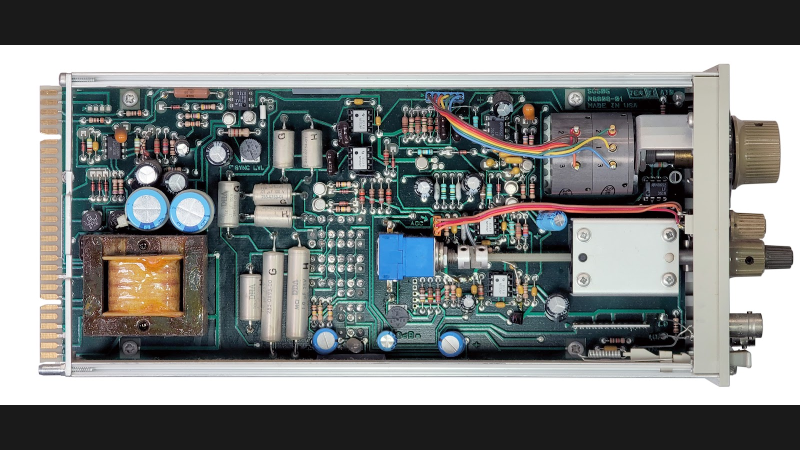Tektronix must have been quite a place to work back in the 1980s. The company offered a bewildering selection of test equipment, and while the digital age was creeping in, much of their gear was still firmly rooted in the analog world. And some of the engineering tricks the Tek wizards pulled off are still the stuff of legend.
One such gem of analog design was the SG505, an ultra-low-distortion oscillator module that [Paul] is trying to replicate with modern parts. That’s a tall order since not only did the original specs on this oscillator call for less than 0.0008% total harmonic distortion over a frequency range of 20 Hz to 20 kHz, but a lot of the components it used are no longer manufactured. Tek also tended to use a lot of custom parts, especially mechanical ones like the barrel switch used to select attenuation levels in the SG505, leaving [Paul] no choice but to engineer his way around them.
So far, [Paul] has managed to track down most of the critical components or source suitable substitutes. One major win was locating the original J-FET Tek used in the oscillator’s AGC circuit. One part that’s proven more elusive is the potentiometer that Tek used to adjust the frequency; who knew that finding a dual-gang precision wirewound 10k single-turn pot with no physical stop would be such a chore?
[Paul] still seems to be very much in the planning stages of this project yet, and that’s probably for the best since projects such as these live and die on proper planning. We’re keen to see how this develops, and we’re very much looking forward to seeing the FFT results. We also imagine he’ll be busting out his custom curve tracer at some point in the build, too.
















There are very few JFETs left in production. There are even fewer low noise parts to choose from.
I’m happy to see that TI introduced JFE150 and JFE2140 recently.
Never used JFETs before. Are they very different from MOSFETs? Anything cool that I can do with them?
JFETs are on with no bias, and turn off when gate voltage is applied (negative in the case of N-channel JFETs, positive in the case of P-channel JFETs). I have used this characteristic several times in designs where a signal had to get through when the power was off (bypassing the active circuitry), and take a different route (through the active circuitry) when the power was on. There’s an analog range in between of course.
In a JFET the gate and the channel form a diode, which is mean to be biassed so that no current flows in the diode. Driving the diode into conduction clamps the gate voltage, probably not a good idea.
MOSFETs work by adjusting an inversion channel under the gate dielectric, while jFETs control the cross section of a non-inverted conducting zone bounded by depletion regions.
Interfaces are trouble because they are “dirty” with defects that affect carrier transport, which gives rise to noise on different timescales. In jFETs, the channel resides deep in the bulk of the semiconductor.
jFETs can be built for power applications, but building good MOSFETs for low noise applications is a different challenge.
I’ve run into the same problem. Wow, thank you for the heads-up on the JFE150 and JFE2140!!
Tektronix was making legendary equipment by the time I first became aware of them in 1968, I think on of the scopes we used at the radio station cost $25,000 the EET’s told me. The company goes back to around 1950, the EET’s considered Tek above the Gold Standard. Located in Portland Oregon at the time if my memory is correct.
Tek was the standard bearer for O-scopes back then, and HP was the equivalent in the world of RF test equipment, particularly with spectrum analyzers. Gold standard? More like the unobtainium standard, when it came to buying one.
I can assure you, Tektronix WAS quite a place to work in the 1980s. I worked in a field office, starting on 7000-series oscilloscopes and 465/475 portables, then moving up to spectrum analyzers in the 7L series and 492/496 portables. Every instrument was a work of art as well as a technological marvel, and I’ve never been more proud of my work than during that period. By the time I left for (sigh) bigger opportunities, the 2215 and 2465 had replaced the 465b, and the 494 and 495 spectrum analyzers were demonstrating what stability really meant. The newer ‘scopes didn’t use tunnel diodes any more for super sharp triggering, because a) newer technologies were as good or better, and b) they were running out of tunnel diodes.
What a place to be and what a time to be there.
I can only fathom what this was used for, but in my head I immediately recognized that this would be fantastic for making techno music
This is the graddaddy forum thread on low distortion oscilators. Its currently 10,000+ messages with lots on good info and a whole lot of responses as well. https://www.diyaudio.com/community/threads/low-distortion-audio-range-oscillator.205304/
The tuning pots need to be low distortion for the system to deliver low distortion. Many pots are not that good. Same for the caps.
The AGC is the most sensitive component once the basics are attented to. Victors oscillator has the best implementation currently. His circuit was published in that long thread.
The digital readout can send noise back through everything if not very carefully implemented. Lots of shielding and isolation help. You will be generating 3V+ signal and the nises will be at less than 3 microvolts, a really serious challenge. I’ll be watching for your success.